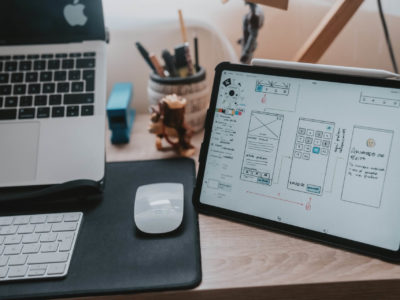Most web users nowadays use mobile devices to surf the internet. And if they like a certain brand or website, they download its mobile app for their convenience. However, 56% of users uninstall apps within a week of installation. The reason? They found its overall experience confusing or frustrating.
Some organizations make the mistake of only focusing on user interface (UI) design and ignoring ease of use, so they find it difficult to increase app use and engagement. This is why mobile user experience (UX) is critical in the success or failure of your business’s mobile app.
If you want to boost engagement and lead generation, your mobile app should offer a top-notch experience to convince users that this application is a must-have in their day-to-day lives.
Knowing the ins and outs of user experience, our web design team has created a list of dos and don’ts of mobile UX design.
Best Practices for Mobile User Experience Design
1. Focus on the user, not the product
User experience has always been important to users. But today, it’s more critical than ever, with most users being Generation Z and Millennials.
If you are developing a mobile application for your business, focus on the pain points, needs, and expectations of your target audience. This means understanding the common challenges people face when using mobile apps, what they plan to use the app for, and what they expect to see on the app.
Weave all of these factors into your user experience design to enable your customers to engage with your app smoothly. When they can navigate your mobile app without any problems, they’re more likely to integrate its use into their daily lives.
2. Short-list the features
Have you ever used a mobile app with a home page full of features? You might see an option for signing in, a program that lets you earn points and other elements at the top panel. You’ll also find product categories with discounts and offers crammed into your mobile screen. Unfortunately, you have to squint.
This is what we call bad UX design. You shouldn’t commit this mistake in your app. Otherwise, people will just uninstall it that same day.
Make a list of all the features you want to add to your app and then categorize them according to their function. Then, create a collapsible menu or dashboard that organizes these features clearly, so that users can navigate your app features smoothly.
3. Concise and clear navigation
UX design for mobile should be straightforward. Your app’s consumer should be able to walk through the app without heading to your help section.
Try to carve a clear navigation path. Remove unnecessary aspects within the navigation, such as useless features, pop-up elements that frustrate users, and other clutter.
Suppose the end goal of your ideal customer is to schedule an appointment for massage treatment. You can create an information architecture enabling your customer to reach the CTA button saying “Book an Appointment” in the least number of steps possible.
4. Say no to complicated symbols and controls
Functional UX design for mobile apps asks you to choose familiarity over uniqueness. Use standard controls, names, and symbols for navigation to make browsing more intuitive for your users.
Most users want to navigate the app on autopilot without thinking. They expect they have learned by heart how to go about any application. If you fail to meet this expectation, they’ll conclude that your app is hard to use and will end up uninstalling it.
Incorporate standard symbols for actions like add to cart, schedule a consultation, delete, search, and other frequently used controls.
5. Tidy up your app’s interface
Mobile screens have smaller spaces, so you should only add the essential aspects of the app. You should be clear on what your organization wants to achieve with your mobile application and focus on that while designing user experience.
Ideally, your app should only have one or two objectives. This way, you can easily remove the clutter that contains useless information.
Don’t confuse visitors by adding too much content to the app, which is useless to your ideal customer. Ensure your app has an organized user interface that spotlights only the essentials, keeps standard symbols clear, and allows effortless navigation.
Moreover, your text should be easy on the eyes to make your interface accessible to people with visual and cognitive impairments and disabilities.
6. Provide a streamlined experience
Your mobile UX design doesn’t just concern the browsing experience on smartphones. You should also consider how the app performs when accessed on other devices, such as tablets and laptops.
Let’s take WhatsApp, for example. Many people use this communication platform on their smartphones, iPads, and laptops simultaneously. This shows that WhatsApp has successfully created a seamless multi-device experience for its users.
What to Avoid when Designing Mobile User Experience
1. Not testing for usability
Mobile app UX depends on the user’s likes and dislikes. Most app product teams assume what their end-users want and don’t want to see in a mobile app, then they create the UX based on these factors. However, you can only confirm these assumptions by conducting a usability test.
Usability testing checks the UI design functionality, app flow, and user-friendliness. Unlike other internal testing procedures, a usability test requires the participation of end users.
The results of this test assist UX designers in discovering mobile design issues and opportunities for improvement and learning about user interests and behavior.
Additionally, you can check how your app functions on various devices and screen sizes with usability testing. Doing so lets you address issues that make your design look ugly, unresponsive, and unstable on a specific device.
2. Not listening to user feedback
Product teams often fall prey to confirmation bias when developing a mobile app. A team of like-minded people does all the branding, designing, and development working under the impression that the final product will break all records.
But when the app hits the market, users reject it. Why? Because your app’s design is based on your assumptions of your target audience’s needs, not what they actually need.
You might think you researched well enough to know what your customers want to see in your mobile app. But you can be certain once you’ve validated your hypothesis by listening to people’s opinions and reviews.
A feedback loop is necessary, which helps users stay consistent in the design process. You can use the design sprints technique to shift from concept to learning in a couple of days instead of months or years.
3. Seeking perfection at the first go
You should use the iterative methodology when designing your mobile UX. This involves gathering information, creating a hypothesis, building a prototype for your app, and then analyzing the result. One way of doing this is through rapid prototyping.
Mobile app development is an expensive and time-consuming process. You don’t want to build the final version of your app only to find out that users don’t need this product. Therefore, you keep your mobile app as a living project that you continuously develop, tweak, and refine based on user and stakeholders’ feedback.
This is another reason user feedback is important– it holds the key to your mobile app improvement. We don’t test our app by ourselves since our judgments might be clouded. Instead, we conduct alpha and beta testing.
Allowing people to try the app and give their feedback lets us see problems on the end-user side of things that we may not have anticipated. This way, your app stays aligned with your audience’s ever-changing needs and expectations, ensuring that it will never become obsolete.
4. Having slow-loading content
Your designers can make the most interactive mobile UI design, but you can’t win customers if your users doze off while your content takes ages to download.
A seamless user experience needs loading at lightning-bolt speed. Angry users often head to the app store and write negative reviews about an app that makes them wait for content to load. These negative reviews can ruin your app’s and your company’s reputation. Slow-loading content also results in a higher churn rate for your app.
5. Building dead-end pages
Sometimes, when we click on an app’s button, it leads us to a dead-end page, meaning a blocker. Not every user is tech-savvy, so they might get confused and won’t understand what to do next.
Dead-end pages mess with a consistent app flow, destroying your mobile UX design. Also, users sometimes carry out unwanted actions by clicking at the wrong place in confusion. Make sure you guide users even on empty and error states on how to move along.
FAQs about User Experience
- What is UX design?
User experience (UX) is the method designers use to develop products that offer insightful and relevant experiences to consumers. It’s the complete process of attaining and integrating the product, involving elements of branding, user-friendliness, function, and layout.
- What is mobile UX design?
Mobile UX design refers to the user experience design for wearable and hand-held devices. UX design professionals develop solutions (usually apps) to fulfill mobile users’ specific needs and limitations. They work on engaging mobile device experiences by improving discoverability, accessibility, and efficiency.
- What are some challenges that your UX design team faces?
UX designers face difficulty demonstrating to particular stakeholders that their design approach is not too pricey and time-consuming. Another big challenge is to perform user research in unique ways. UX designers also find it challenging to assess, collect and translate quantitative and qualitative consumer data into practical insights.
Understanding Mobile UX
Developing another mobile application and publishing it with a sea of similar apps won’t do any good to your organization. Everyone can integrate new trends and technologies to enable cutting-edge features and functionalities. However, a functional, user-friendly, and engaging user experience design can make your app stand out from the rest.
Invest time, money, and labor into developing and improving your mobile app’s user experience and we’re certain you’ll reap the rewards in the form of higher app usage and engagement.





